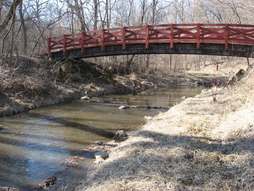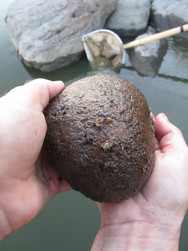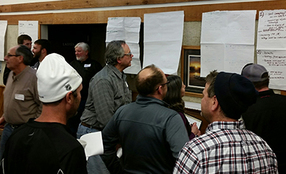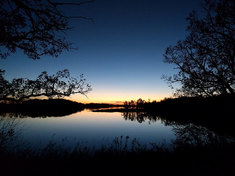October 2017
 The MPCA is proposing to remove nine water bodies from the 2018 draft list of impaired waters because of restorative actions to improve water quality:
-
First Fulda Lake (Murray County) now has nutrient levels low enough to meet recreation standards.
- The Poplar River (Superior Hiking Trail Bridge to Lake Superior, in Cook County) is now clear enough to meet the standard for aquatic life such as fish.
-
Bryant Lake (Hennepin County), Crystal Lake (Dakota County), Gem Lake (Ramsey County), McMahon Lake (Scott County), and Mitchell Lake (Hennepin County) now have nutrient levels low enough to meet recreation standards.
-
Seven Mile Creek (in photo) (Nicollet County) now has pesticide levels low enough to meet the standard for aquatic life such as fish.
- The Clearwater River from Judicial Ditch 1 to the Lost River (Red Lake County), and from Ruffy Brook to Judicial Ditch 1 (Clearwater County), now has oxygen levels high enough to meet the standard for aquatic life such as fish.
With 618 new listings, the draft 2018 list totals 5,101 impairments, covering a total of 2,669 water bodies across the state (many water bodies are impaired by several pollutants). Minnesota is detecting more waters in trouble because of its 10-year plan to study all 80 major watersheds in the state, funded by the Clean Water, Land and Legacy Amendment. The MPCA has started this study in all but a few watersheds. Public meetings to discuss the draft are scheduled in November. News release.
Back to top
|
 Following the well-attended series of water quality town hall meetings this summer and early fall, Gov. Dayton's office is reviewing thousands of comments and suggestions about improving water quality in Minnesota. "We are in the process of sorting through all the great input we received and we can expect a report back to the public in early winter," says Katie Pratt of the Environmental Quality Board.
A total of more than 2,000 people attended the nine town halls, at least 500
participated online and via community meetings, and hundreds of fourth graders
interacted with '25 by 25' at the Metro Water Festival. Throughout the process, Minnesotans showed enthusiasm for
working together and bringing innovative ideas forward. All public comments from the town hall meetings are available on
line here. Photo: Sept. 6 meeting at St. Cloud.
Back to top
|
 Greg Page,
retired CEO and chairman of Cargill, will keynote the lunch session of the Water Resources Conference Oct. 17, speaking
on "Water Quality and Agriculture." In recent years Page has
been a noted speaker on promoting cooperative and community approaches to
addressing water quality and agriculture. The conference is Oct. 17-18 at the
St. Paul RiverCentre, offered by the U of M Water Resources Center.
Speaking at the Jan. 27 water town hall summit in Morris and
reported in Agri-News, Page said "we need change in collective
behavior," and that starts with
building trust with the farming community. Building trust reduces resistance to
change and will help solve the water quality problem faster. Page would like to see a “localized,
nuanced response to the state’s water quality issues." One place to start
may be with an action plan through the Crop Improvement Association in every
county. Full story. (Photo: Kansas Ag Network).
Back to top
|
 As part of its statewide checkup of lakes and streams, the MPCA studied the entire length of the Minnesota River and recently released a summary of its findings. Overall, the Minnesota River is suffering in water quality. Sediment clouds the water, phosphorus fuels algae growth, nitrogen and bacteria pose health risks. Too much water flowing into the river plays a big part in all these problems. There’s more rain, more artificial drainage, and not enough places to store this water. Worse yet, the landscape is naturally vulnerable to erosion. “There are no magic solutions. Government alone cannot solve this. This study informs us to focus our actions, and people must work together to find solutions,” said Glenn Skuta, director of the MPCA Watershed Division.
There are some signs of progress. Many farmers are exploring and using conservation practices such as minimum tillage, cover crops and building soil health. The fish population is generally healthy, though there are concerns about aquatic insects that are food sources for fish. Cities and industries have improved wastewater treatment, vastly reducing the phosphorus they discharge to the Minnesota River basin. Local watershed organizations help landowners with water quality projects such as buffer strips and grass waterways. But there is still more to do if Minnesota’s namesake river is to meet water quality standards designed to protect river life and recreation.
Back to top
|
 Lake Pepin Legacy Alliance offers an interactive web application to explore sedimentation and eutrophication concerns in the lake. It focuses on the Minnesota River basin, which contributes about 90 percent of sediment accumulating at the head of Lake Pepin. Users can read the application like a storybook or simply explore county and watershed level data visualized as maps. Go the the LPLA website and click the "projects" tab. Direct link to the story map page. For more information contact Mackenzie Consoer at mackenzie.consoer@lakepepinlagacyalliance.org.
Back to top
|
The Watershed Professionals Network fall program is scheduled for 9 a.m.-noon Tuesday, Nov. 28 at the New Ulm DNR office. Tentative program topics include: Zonation and its role in One Watershed One Plan, Watershed Health Assessment Framework, and biomonitoring. Communication among watershed organization staff enhances efforts to restore and protect water quality. The program is designed to help staff learn and share their experiences. It provides a monthly e-newsletter and hosts meetings in the spring and fall. This will be the 17th program since starting in 2009.
Back to top
 The Missouri River Basin Watersheds of
Minnesota Watershed Restoration and Protection Strategy (WRAPS) report and Total Maximum Daily Load (TMDL) report are available for public
comment through Oct. 25, 2017.
The headwaters of the Upper Big Sioux, Lower Big Sioux, Rock, and
Little Sioux rivers watersheds lie in portions of six counties: Lincoln, Pipestone, Murray,
Rock, Nobles and Jackson. Leaving Minnesota, they flow into Iowa and South
Dakota.
Generally, most streams and lakes in the watersheds fail to support
swimming or fishing. Stream
bank erosion and stormwater runoff degrade water quality with sediment, excess
nutrients, and bacteria, and are harmful to fish and other aquatic life. Photo: Rock River. News release.
The reports are posted on the four watershed web pages in
this basin:
Back to top
|
 Each year the MPCA’s Biological Monitoring Unit samples biological communities from about 200-400 sites on rivers, streams, and ditches throughout Minnesota. These waterways range in size from a few feet wide to large main-stem waterways, such as the Mississippi or Minnesota river.
Fish are sampled once per site from June through September, using electrofishing. Fish are separated by species, and counted, measured, weighed and released back into the stream.
Bugs, or macroinvertebrates, are sampled once from August through September at the same locations where fish are sampled. A specialized net is used to take 20 individual samples from the most dominant habitat types: rocky areas, instream vegetation, undercut banks, woody debris, and/or and piles of leaves in the stream.
Fish and macroinvertebrates are a great indicator of stream health because some species are sensitive to disturbances. This sensitivity allows biologists to assess where issues may exist based on the communities present. For example, some fish are very tolerant of low dissolved oxygen levels while others are extremely sensitive to low dissolved oxygen levels. Looking at biological samples, habitat assessments, and water chemistry samples can provide a good picture of the stream health. Examples of potential problems may include low dissolved oxygen, high sediment concentrations, agricultural or industrial runoff, or lack of habitat. The information gathered can guide watershed partners to restoration or protection efforts.
For more information contact Tony Dingmann, anthony.dingmann@state.mn.us, 218-316-3914. Biological monitoring webpage.
Back to top
|
 Hawk Creek WRAPS
The
Watershed Restoration and Protection Strategy for Hawk Creek has been approved
by the MPCA, and has been forwarded to the U.S. EPA. The final WRAPS
report is posted on the Minnesota River-Yellow Medicine River Watershed web page. (Photo: Discussion at a Hawk Creek WRAPS public workshop in early 2016.)
Sauk River bacteria and nutrient TMDL
The Sauk River Bacteria and Nutrient TMDL was
approved by EPA on Sept. 26. The final TMDL is posted on the Sauk
River Watershed web page along with the EPA approval letter and decision
document. The Approved
WRAPS/TMDLs web page has also been updated.
Pioneer-Sarah Creek Watershed TMDL
The Pioneer-Sarah Creek Watershed TMDL was
approved by EPA on Sept. 29. The final TMDL is posted on the Pioneer-Sarah
Creek Watershed web page along with the EPA approval letter and decision
document. The watershed is located in northwestern Hennepin County and includes the cities of Greenfield, Independence, Loretto, Maple Plain, Medina, and Minnetrista. The northern part of the Pioneer-Sarah Creek watershed is located within the North Fork Crow River Watershed, and the southern portion is located within the South Fork Crow River Watershed of the Upper Mississippi River basin.
WRAPS reports identify impaired water bodies in a watershed and those in need of protection, and identifies the actions needed to achieve and maintain water quality. Total Maximum Daily Load reports quantify the pollutant levels, identifies pollution sources, and proposes ways to return water quality to an acceptable level.
Back to top
|
 Entries due Nov. 1 for Chippewa calendar photo contest
It's time to send in photos
of your favorite places in the Chippewa River Watershed. Entries for the 2018
Calendar Photo Contest are being accepted through Nov. 1.
Winning photos will be featured in a calendar and the Best in Show photographer
will receive $50.
Anyone is eligible to enter
the contest; you do not need to live in the watershed to submit a photo. However,
the photo must be taken in the Chippewa River Watershed, which includes many
tributaries and lakes and parts of eight counties. For contest
rules, registration forms, and watershed map, visit the Chippewa River Watershed Project’s
website www.chippewariver.org or
call 320-321-1718. (Photo: 2017 photo contest winner).
Carlin named Seven Mile Creek Watershed Project manager
Susie Carlin started in April as manager of the Seven Mile Creek Watershed Project, working with water quality technician Eric Miller of the Nicollet County SWCD. Previously, Carlin was with the Water Resources Center at Minnesota State University-Mankato as program director for the former Minnesota River Board. She is also a member of the St. Peter City Council. She follows Karen Galles, who currently is land and water unit supervisor for Hennepin County Environment and Energy.
Dept. of Agriculture to hire research scientist
This person will work in the Dept. of Agriculture Clean Water Technical Assistance Unit
(Pesticide and Fertilizer Management Division) located
in St. Paul. The job posting is on the State of Minnesota Career
Website and will remain open for 30 days (Oct. 11-Nov. 13). The Job ID is #17100.
This Research Scientist
position serves as a technical expert for the MDA on impaired waters issues in agricultural landscapes.
Responsibilities include managing MDA’s Clean Water Research Program including;
identifying research priorities, developing request for proposals, selecting
researchers and institutions, and providing direction on projects. This
position also supports MDA-led research and demonstration projects on topics
related to nutrient management, cover crops, vegetative cover and other topics
related to agriculture and water quality.
Students can apply for AmeriCorps ag outreach positions
Conservation Corps Minnesota and Iowa is accepting applications for young adults, ages 18-25, for an AmeriCorps Agriculture and Water Outreach Corpsmember position in Windom. The AmeriCorps Agriculture and Water Outreach Corpsmember (age 18-25) serves alongside natural resource professionals with the Dept. of Agriculture supporting the work of the Minnesota Agricultural Water Quality Certification Program (MAWQCP).
Placement will serve as an AmeriCorps member and receive a monthly living stipend of $1,690 as well as an education award of $5,815 to use towards qualifying education and student loan expenses. Educational credits may be arranged by the placement. The service term runs from Jan. 15 to Dec. 13, 2018. More information at www.conservationcorps.org/individual-placements.The application deadline is Oct. 13.
Back to top
|
|